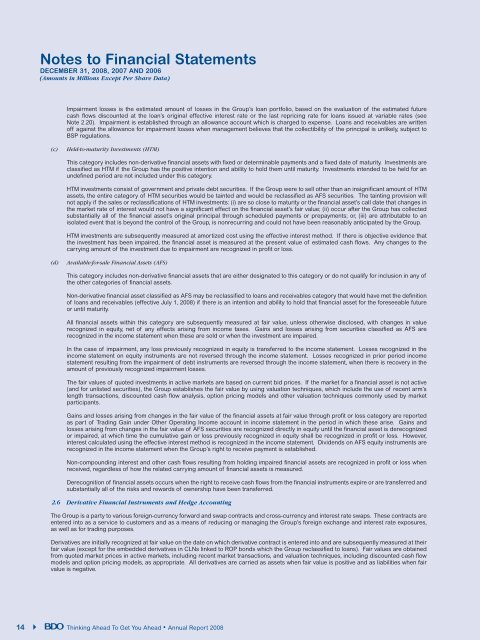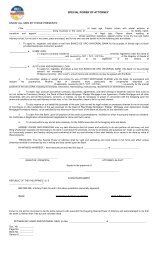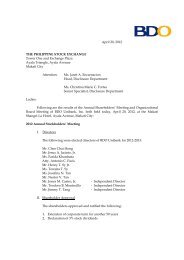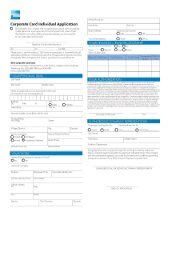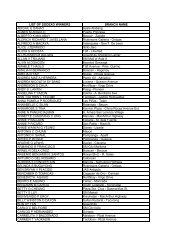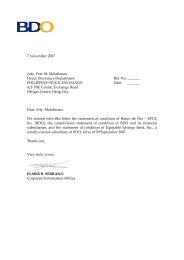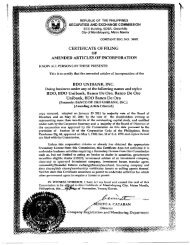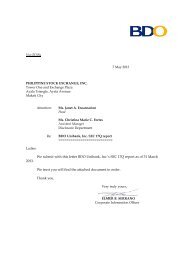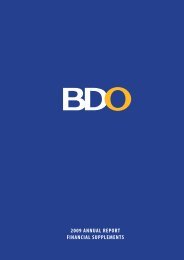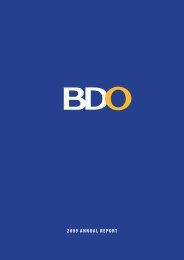Notes to Financial Statements - BDO
Notes to Financial Statements - BDO
Notes to Financial Statements - BDO
Create successful ePaper yourself
Turn your PDF publications into a flip-book with our unique Google optimized e-Paper software.
<strong>Notes</strong> <strong>to</strong> <strong>Financial</strong> <strong>Statements</strong>DECEMBER 31, 2008, 2007 AND 2006(Amounts in Millions Except Per Share Data)Impairment losses is the estimated amount of losses in the Group’s loan portfolio, based on the evaluation of the estimated futurecash flows discounted at the loan’s original effective interest rate or the last repricing rate for loans issued at variable rates (seeNote 2.20). Impairment is established through an allowance account which is charged <strong>to</strong> expense. Loans and receivables are writtenoff against the allowance for impairment losses when management believes that the collectibility of the principal is unlikely, subject <strong>to</strong>BSP regulations.(c)Held-<strong>to</strong>-maturity Investments (HTM)This category includes non-derivative financial assets with fixed or determinable payments and a fixed date of maturity. Investments areclassified as HTM if the Group has the positive intention and ability <strong>to</strong> hold them until maturity. Investments intended <strong>to</strong> be held for anundefined period are not included under this category.HTM investments consist of government and private debt securities. If the Group were <strong>to</strong> sell other than an insignificant amount of HTMassets, the entire category of HTM securities would be tainted and would be reclassified as AFS securities. The tainting provision willnot apply if the sales or reclassifications of HTM investments: (i) are so close <strong>to</strong> maturity or the financial asset’s call date that changes inthe market rate of interest would not have a significant effect on the financial asset’s fair value; (ii) occur after the Group has collectedsubstantially all of the financial asset’s original principal through scheduled payments or prepayments; or, (iii) are attributable <strong>to</strong> anisolated event that is beyond the control of the Group, is nonrecurring and could not have been reasonably anticipated by the Group.HTM investments are subsequently measured at amortized cost using the effective interest method. If there is objective evidence thatthe investment has been impaired, the financial asset is measured at the present value of estimated cash flows. Any changes <strong>to</strong> thecarrying amount of the investment due <strong>to</strong> impairment are recognized in profit or loss.(d)Available-for-sale <strong>Financial</strong> Assets (AFS)This category includes non-derivative financial assets that are either designated <strong>to</strong> this category or do not qualify for inclusion in any ofthe other categories of financial assets.Non-derivative financial asset classified as AFS may be reclassified <strong>to</strong> loans and receivables category that would have met the definitionof loans and receivables (effective July 1, 2008) if there is an intention and ability <strong>to</strong> hold that financial asset for the foreseeable futureor until maturity.All financial assets within this category are subsequently measured at fair value, unless otherwise disclosed, with changes in valuerecognized in equity, net of any effects arising from income taxes. Gains and losses arising from securities classified as AFS arerecognized in the income statement when these are sold or when the investment are impaired.In the case of impairment, any loss previously recognized in equity is transferred <strong>to</strong> the income statement. Losses recognized in theincome statement on equity instruments are not reversed through the income statement. Losses recognized in prior period incomestatement resulting from the impairment of debt instruments are reversed through the income statement, when there is recovery in theamount of previously recognized impairment losses.The fair values of quoted investments in active markets are based on current bid prices. If the market for a financial asset is not active(and for unlisted securities), the Group establishes the fair value by using valuation techniques, which include the use of recent arm’slength transactions, discounted cash flow analysis, option pricing models and other valuation techniques commonly used by marketparticipants.Gains and losses arising from changes in the fair value of the financial assets at fair value through profit or loss category are reportedas part of Trading Gain under Other Operating Income account in income statement in the period in which these arise. Gains andlosses arising from changes in the fair value of AFS securities are recognized directly in equity until the financial asset is derecognizedor impaired, at which time the cumulative gain or loss previously recognized in equity shall be recognized in profit or loss. However,interest calculated using the effective interest method is recognized in the income statement. Dividends on AFS equity instruments arerecognized in the income statement when the Group’s right <strong>to</strong> receive payment is established.Non-compounding interest and other cash flows resulting from holding impaired financial assets are recognized in profit or loss whenreceived, regardless of how the related carrying amount of financial assets is measured.Derecognition of financial assets occurs when the right <strong>to</strong> receive cash flows from the financial instruments expire or are transferred andsubstantially all of the risks and rewards of ownership have been transferred.2.6 Derivative <strong>Financial</strong> Instruments and Hedge AccountingThe Group is a party <strong>to</strong> various foreign-currency forward and swap contracts and cross-currency and interest rate swaps. These contracts areentered in<strong>to</strong> as a service <strong>to</strong> cus<strong>to</strong>mers and as a means of reducing or managing the Group’s foreign exchange and interest rate exposures,as well as for trading purposes.Derivatives are initially recognized at fair value on the date on which derivative contract is entered in<strong>to</strong> and are subsequently measured at theirfair value (except for the embedded derivatives in CLNs linked <strong>to</strong> ROP bonds which the Group reclassified <strong>to</strong> loans). Fair values are obtainedfrom quoted market prices in active markets, including recent market transactions, and valuation techniques, including discounted cash flowmodels and option pricing models, as appropriate. All derivatives are carried as assets when fair value is positive and as liabilities when fairvalue is negative.14Thinking Ahead To Get You Ahead • Annual Report 2008


